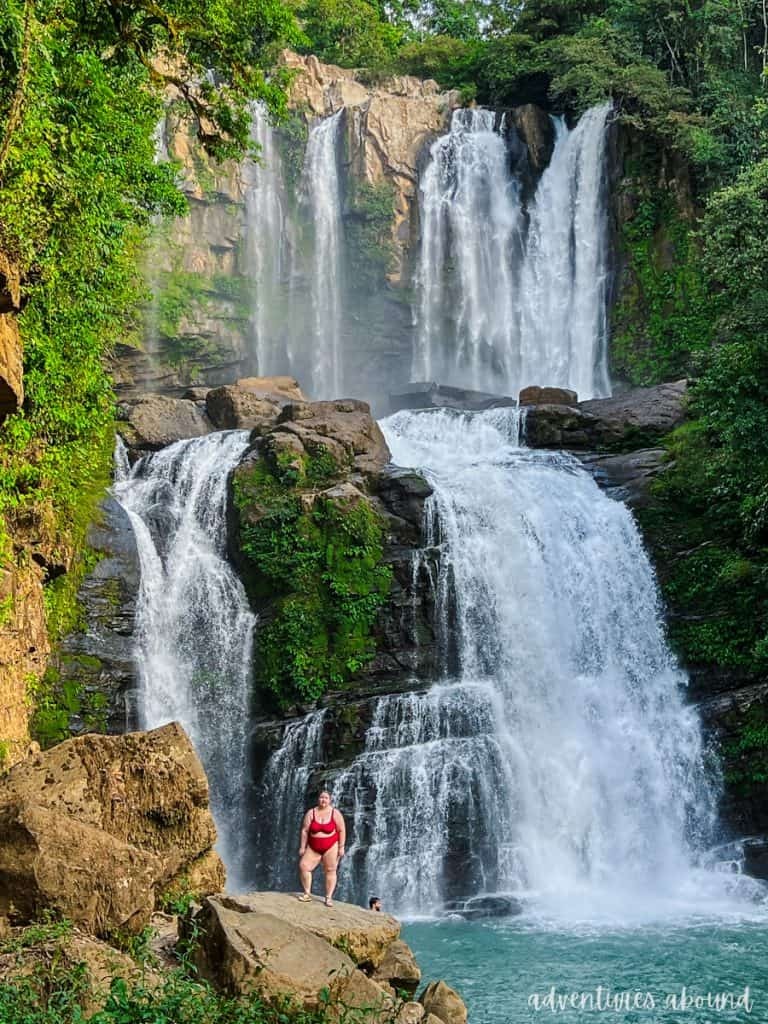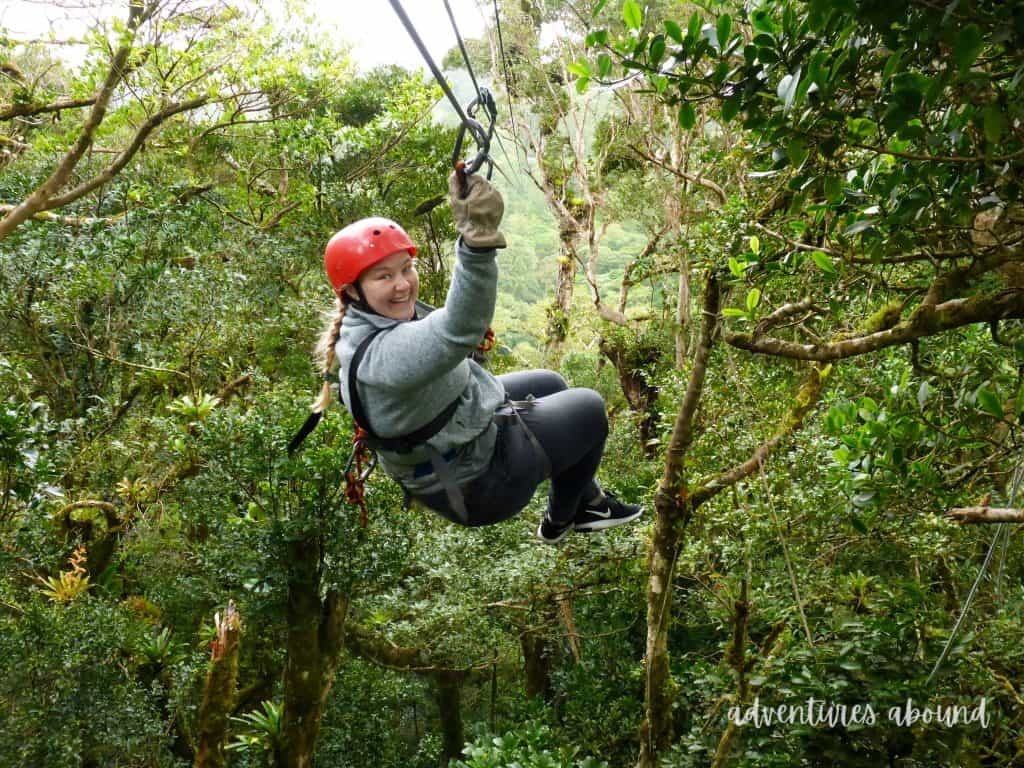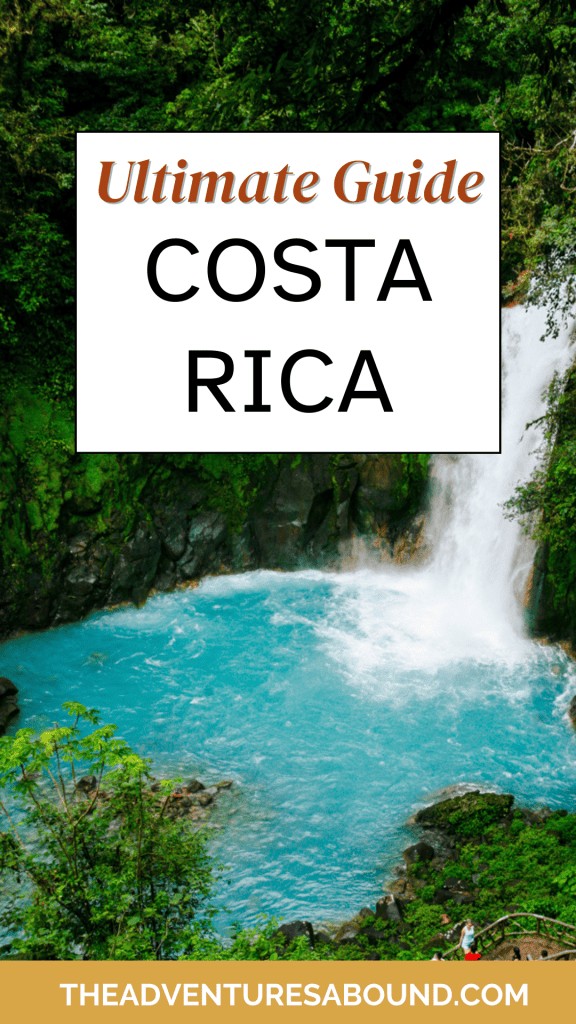Costa Rica, my first foray out of my home country, instantly captivated me. For over a decade, I’ve returned to this incredible destination, a place I didn’t just visit, but fell in love with – literally, as it’s where I met and married my Costa Rican partner.
Having explored Costa Rica extensively over the past 11 years – from studying abroad and working with field study programs to countless personal trips – I’ve uncovered its hidden gems and must-see spots. I’m thrilled to share my comprehensive Costa Rica Travel Guide, packed with everything you need to plan your own unforgettable journey.
Essential Information for Your Costa Rica Trip
Nestled in Central America, Costa Rica sits between Nicaragua and Panama, boasting both Pacific and Caribbean coastlines.
Language: Spanish is the official language of Costa Rica. You’ll also encounter “Tico Spanish,” a unique dialect with its own Costa Rican slang. English is increasingly spoken, particularly among younger generations and in tourist areas. On the Caribbean coast, a vibrant English Creole is prevalent.
 A woman in a red swimsuit poses on a rock in front of Nauyaca Waterfall, Costa Rica
A woman in a red swimsuit poses on a rock in front of Nauyaca Waterfall, Costa Rica
Visa Requirements: For tourists from the United States, a visa is not required for stays up to 180 days. Ensure your passport is valid for at least six months beyond your intended stay. While Costa Rican entry might be permitted with a shorter passport validity, most US airlines enforce a stricter six-month rule. For those seeking longer stays, Costa Rica offers digital nomad visas valid for up to two years, perfect for remote workers.
Currency: The Costa Rican Colón (CRC) is the official currency. The exchange rate fluctuates, but generally hovers around 500 CRC to 1 USD. Costa Rica is known as the most expensive country in Central America. While you can find budget-friendly options, prices often rival those in the United States, especially for tourist activities and accommodations.
Weather: Costa Rica enjoys warm weather throughout the year. San José, situated in a valley, experiences cooler temperatures than the coastal regions. The country has distinct wet and dry seasons. The rainy season spans from May to November, while the dry season runs from December to April, offering sunny skies and less rainfall. December acts as a transitional month. The Caribbean coast exhibits a different pattern, receiving more rain and experiencing shorter dry seasons in March-April and September-October. Keep in mind the El Niño/La Niña weather patterns, which can influence Costa Rica’s climate, bringing drier conditions during El Niño and wetter conditions during La Niña years.
Provinces: Costa Rica is divided into seven provinces, each offering unique experiences for travelers:
- Guanacaste: Famous for its Pacific coastline, stunning beaches, and surfing havens.
- Puntarenas: The largest province, boasting diverse wildlife and national parks along the Pacific Coast, ideal for adventure seekers.
- Alajuela: Home to impressive volcanoes and verdant coffee plantations in the inland region.
- Heredia: Known as ‘Little Switzerland’ for its rolling green hills and charming villages.
- San José: The vibrant capital city, blending urban life with cultural richness.
- Cartago: Showcasing Costa Rica’s colonial heritage with historical architecture and ancient sites.
- Limón: Infused with Afro-Caribbean culture, offering unique cuisine, music, and lush rainforests on the Caribbean coast.
What Makes Costa Rica a Traveler’s Paradise?
Costa Rica’s allure stems from its diverse offerings, making it a top destination in any [costa rica travel guide](costa rica travel guide).
World-Class Coffee: Coffee and Costa Rica are inseparable. The aroma of roasting coffee beans permeates daily life, a cherished ritual in homes and cafes. It was in Costa Rica that I truly learned to appreciate high-quality black coffee. The country’s high altitudes and volcanic soil produce beans with distinctive flavors, making Costa Rican coffee highly prized globally. From trendy San José cafes to family-run coffee farms in Alajuela, experiencing Costa Rican coffee is a cultural immersion and a source of national pride.
Unparalleled Nature: Despite its small size (approximately 20,000 square miles), Costa Rica is a natural wonder. It boasts an incredible array of landscapes: pristine beaches, breathtaking waterfalls, lush rainforests, ethereal cloud forests, winding rivers, rejuvenating hot springs, majestic volcanoes, and even bioluminescent bays. Adventure and nature await at every turn.
Adventure Travel Hub: Costa Rica is synonymous with adventure. Thrill-seekers flock here for ziplining through rainforest canopies, exhilarating white-water rafting, world-class surfing waves, skydiving with stunning views, canyoning down waterfalls, and countless hiking trails. The possibilities for adrenaline-pumping activities are endless.
 A woman ziplining through the lush rainforest canopy in Monteverde, Costa Rica
A woman ziplining through the lush rainforest canopy in Monteverde, Costa Rica
Biodiversity and Wildlife Encounters: Costa Rica is a biodiversity hotspot, housing 4% of the world’s biodiversity within just 0.03% of the Earth’s surface. This natural paradise teems with life, from four monkey species and migrating whales to vibrant tropical birds and nesting turtles. The iconic sloth embodies the laid-back “pura vida” lifestyle. Costa Rica is home to both two-toed and three-toed sloths. Wildlife encounters are commonplace, transforming any trip into an impromptu safari. Whether you’re a dedicated birdwatcher, a marine life enthusiast, or simply an animal lover, Costa Rica’s fauna promises unforgettable moments.
Travel Tip: Keep an eye out for clusters of tourist vehicles or groups on trails. This often signals wildlife sightings – a sloth, toucan, or other fascinating creatures of Costa Rican wildlife.
Rich Culture and History: Beyond nature, Costa Rica offers a rich cultural tapestry. Explore the historical city of Cartago, the former capital, or visit Sarchí, renowned for its vibrant, hand-painted oxcarts, a symbol of Costa Rican artistry. Engage with the “Tico” culture, known for its warmth and “pura vida” philosophy, emphasizing a relaxed and optimistic outlook on life.
 A vibrantly painted, traditional Costa Rican oxcart, showcasing the artistry of Sarchí
A vibrantly painted, traditional Costa Rican oxcart, showcasing the artistry of Sarchí
Navigating Costa Rica: Transportation Options
Getting around Costa Rica offers various options to suit different budgets and preferences, essential information for any [costa rica travel guide](costa rica travel guide).
Public Buses: The most budget-friendly option is Costa Rica’s extensive bus system. It reaches even remote corners of the country, offering an authentic local experience. Buses are a great way to immerse yourself in the culture and practice your Spanish.
Domestic Flights: For time-sensitive travel to remote areas like Tortuguero or Corcovado National Park, consider small domestic flights. While pricier than buses, they are more affordable than private charters and save considerable travel time.
Boats: Boats are a convenient option for reaching destinations like Tortuguero or the Nicoya Peninsula from the mainland, offering faster transit than buses, although at a slightly higher cost.
Private Shuttles: Private shuttles are readily available for tourist routes throughout Costa Rica. Ideal for groups, families, or those with ample luggage, they offer direct and comfortable transportation between popular destinations.
Private Drivers: Hiring a private driver provides personalized transport and local insights. Splitting costs among a group makes this a cost-effective and informative option.
Taxis & Ride-Sharing: Taxis are common in cities and towns. In San José, official taxis are red with yellow triangles. Always ensure the meter (“la maria”) is used or agree on a fare beforehand. Uber operates in Costa Rica, often offering competitive rates, but its legal status is still debated.
Car Rentals: Renting a car provides ultimate freedom to explore Costa Rica at your own pace. However, be aware that insurance is mandatory and can increase the overall cost. Driving conditions can be challenging, especially in cities and rural areas. A 4×4 vehicle is recommended for navigating rougher terrains, especially during the rainy season.
 Two people relaxing in a hot spring pool surrounded by lush greenery in La Fortuna, Costa Rica
Two people relaxing in a hot spring pool surrounded by lush greenery in La Fortuna, Costa Rica
Must-Do Activities and Destinations in Costa Rica
Costa Rica offers a plethora of activities and destinations, ensuring something for every traveler, as highlighted in any good [costa rica travel guide](costa rica travel guide).
San José: While often overlooked as a transit hub, Costa Rica’s capital, San José, has cultural gems. Explore museums, savor international cuisine, and relax in urban parks.
Beaches: Costa Rica’s beaches are world-renowned. Popular Pacific beaches include Papagayo, Tamarindo, Playa Conchal, Playas del Coco (Guanacaste), Montezuma, Sámara, Nosara, Manzanillo (Nicoya Peninsula), Jacó, Playa Hermosa, Punta Leona, Manuel Antonio, Dominical, and Uvita. On the Caribbean coast, Puerto Viejo’s beaches like Playa Negra, Playa Cocles, Punta Uvita, Playa Chiquita, and Playa Manzanillo are favorites.
Volcanoes: Explore Costa Rica’s impressive volcanoes: Irazú, Poás, Arenal, Rincón de la Vieja, and Tenorio. Each offers unique landscapes and hiking opportunities. Irazú, Poás, and Arenal are easily accessible for day trips from San José.
National Parks: Costa Rica’s national parks showcase incredible biodiversity.
- Braulio Carrillo National Park: Accessible from San José, ideal for hiking and wildlife spotting.
- Carara National Park: A birdwatcher’s paradise, bridging Amazonian and Mesoamerican ecosystems.
- Cahuita National Park: Caribbean coast park with coral reefs, beaches, and rainforests, perfect for snorkeling and wildlife viewing.
- Tortuguero National Park: A network of mangroves and lagoons, famous for sea turtle nesting.
- Manuel Antonio National Park: Small but stunning, with beaches, trails, and abundant wildlife.
- Chirripó National Park: Home to Costa Rica’s highest peak, offering challenging hikes and panoramic views.
- Palo Verde National Park: In Guanacaste, a haven for waterbirds and migratory species.
- Corcovado National Park: Considered one of the most biodiverse places on Earth, for adventurous travelers seeking rare wildlife encounters.
Other Popular Destinations:
- Monteverde: Famous for its cloud forests, mist-shrouded landscapes, incredible biodiversity, and world-class ziplining.
- La Fortuna: Near Arenal Volcano, an adventure hub for hiking, rafting, horseback riding, and home to La Fortuna Waterfall, La Paz Gardens, and numerous hot springs.
- Río Celeste: Located in Tenorio Volcano National Park, a river with striking turquoise waters flowing through dense jungle.
- Osa Peninsula: A remote and biodiverse region encompassing Corcovado National Park, Drake Bay, and Puerto Jiménez, perfect for eco-tourism and wildlife observation.
 A couple sitting on grass in a San Jose park, enjoying a local art festival
A couple sitting on grass in a San Jose park, enjoying a local art festival
Day Trips from San José:
- Cartago: The former capital, featuring the Basilica of Our Lady of the Angels and Santiago Apostol Church ruins, gateway to Irazú Volcano National Park.
- Alajuela: Birthplace of national hero Juan Santamaría, with museums, Central Park, and Zoo Ave wildlife rescue center.
- Heredia: “City of Flowers,” known for colonial architecture, the Church of the Immaculate Conception, and Café Britt coffee farm.
- Sarchí: Famous for colorful oxcarts and handicrafts, home to the world’s largest hand-painted oxcart.
- Zarcero: Mountain town with whimsical topiary gardens and the unique pink and blue Zarcero Church.
- Orosi: Tranquil valley with the oldest church in Costa Rica still in use, Tapanti National Park, and local hot springs.
Staying Safe in Costa Rica
Costa Rica is generally safe for travelers, but petty theft can occur, especially in urban areas. Safety tips are crucial for any [costa rica travel guide](costa rica travel guide).
Petty Theft: Be mindful of pickpocketing in cities like San José. Keep valuables secure, use front pockets or closed bags, and avoid displaying expensive items. Carry bags in front of you in crowded areas. Avoid walking alone at night.
Emergency Number: 911 is the emergency number in Costa Rica.
Travel Insurance: Travel insurance is highly recommended to cover medical emergencies, theft, and trip disruptions.
 Fern leaves atop a banana leaf, showcasing Costa Rica's rich biodiversity
Fern leaves atop a banana leaf, showcasing Costa Rica's rich biodiversity
Costa Rica Travel FAQs
What is the best time to visit Costa Rica?
The dry season, from December to April, is ideal. To avoid crowds, especially during Christmas and Holy Week (late March/early April), consider traveling outside these peak local travel periods.
Is Costa Rica safe for travel?
Yes, Costa Rica is generally safe. However, be aware of petty theft, especially in tourist areas and cities. Take precautions like securing valuables and avoiding walking alone at night.
Is Costa Rica expensive?
Costa Rica is relatively expensive compared to other Central American countries. Tourist areas often have prices comparable to, or slightly lower than, the United States. Local food and public transport can be more budget-friendly.
Is tipping customary in Costa Rica?
Most restaurants include a 10% service charge. Additional tipping is not mandatory but becoming more common in tourist areas. Locals typically do not leave extra tips.
Is it illegal to take sand or shells from Costa Rica?
Yes, removing sand or shells is prohibited. Airport security will confiscate these items to preserve the natural environment.
Can you drink tap water in Costa Rica?
Yes, tap water is generally safe throughout Costa Rica, except in the Puerto Viejo area on the southern Caribbean coast, where bottled water is recommended.
Your Costa Rican Adventure Awaits
Costa Rica holds a special place in my heart, and I hope this guide inspires you to explore its wonders. It’s an ideal destination for first-time international travelers, offering ease of navigation and opportunities to learn Spanish. With its unparalleled nature and diverse activities, Costa Rica promises an unforgettable experience, whether you have a week or several months to explore.
Start planning your Costa Rican escape today and discover “pura vida” for yourself!
Stay Updated! Subscribe to our newsletter for more Costa Rica travel tips and adventure guides.
Pin for Later!
[
 Costa Rica Pin 1
Costa Rica Pin 1